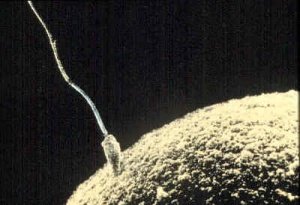
A sperm attempting to fertilize an egg
Fertilisation (also known as fertilization and syngamy) is the process of a sperm fusing with an ovum, which eventually leads to the development of an embryo.
The whole process of development of new individuals is called procreation.
Fertilization in mammals
To deliver the sperm to the female, the male inserts his sexual organ, the penis, into the opening of the vagina, the passage into the female's other sexual organs. (This process is a part of copulation.) Once the male ejaculates, a large number of sperm cells travel toward the ovum.
The capacitated spermatozoon and the oocyte meet and interact in the ampulla of the fallopian tube. In mammals, binding of the spermatozoon to the zona pellucida, an extracellular layer surrounding the oocyte, initiates the acrosome reaction. This process releases the enzyme hyaluronidase, which digests the matrix of hyaluronic acid in the vestments surrounding the oocyte. Fusion between the sperm and oocyte plasma membranes follows, allowing the entry of the sperm nucleus, mitochondria, centriole and flagellum into the oocyte.
This process ultimately leads to the formation of a diploid cell called a zygote. Once this happens, the female is said to be pregnant.
Fertilization in plants
After the female part of the flower is pollinated, pollen grains attempt to travel into the ovary by creating a path called "pollen tube." The pollen tube does not directly reach the ovary in a straight line. It travels near the skin of the style and curls to the bottom of the ovary, then near the receptacle , it breaks through the ovule and reaches the ovum to fertilize it. After being fertilized, the ovary starts to swell and becomes a fruit.
With multi-seeded fruits, multiple grains of pollen are necessary for syngamy with each ovule. The process is easy to visualize if one looks at corn silk, which is the female flower of corn. Pollen from the tassel (the male flower) falls on the sticky external portion of the silk, then pollen tubes grow down the silk to the attached ovule. The dried silk remains inside the husk of the ear as the seeds mature, so one can carefully remove the husk to show the floral structures. The development of the flesh of the fruit is proportional to the percentage of fertilized ovules. For example, with watermelon, about a thousand grains of pollen must be delivered and spread evenly on the three lobes of the stigma to make a normal sized and shaped fruit.
See also
References
- Evans JP, Florman HM. 2002. The state of the union: the cell biology of fertilization. Nature Medicine. 8 Suppl S57-63.